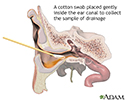Ear drainage culture
Culture - ear drainage
An ear drainage culture is a lab test. This test checks for germs that can cause infection. The sample taken for this test can contain fluid, pus, wax, or blood from the ear.
How the Test is Performed
A sample of ear drainage is needed. Your health care provider will use a cotton swab to collect the sample from inside the outer ear canal. In some cases, a sample is collected from the middle ear during ear surgery.
The sample is sent to a lab and placed on a special dish (culture media).
The lab team checks the dish every day to see if bacteria, fungi, or viruses have grown. More tests may be done to look for specific germs and determine the best treatment.
How to Prepare for the Test
You do not need to prepare for this test.
How the Test will Feel
Using a cotton swab to take a sample of drainage from the outer ear is not painful. However, ear pain may be present if the ear is infected.
Ear surgery is done using general anesthesia. You will be asleep and feel no pain.
Why the Test is Performed
The test may be done if you or your child has:
- An ear infection that is not getting better with treatment
- An infection of the outer ear (otitis externa)
- An ear infection with a ruptured eardrum and draining fluid
It may also be done as a routine part of myringotomy.
Note: Ear infections are diagnosed based on symptoms rather than using a culture.
Normal Results
The test is normal if there is no growth on the culture.
Normal value ranges may vary slightly among different laboratories. Talk to your provider about the meaning of your specific test results.
What Abnormal Results Mean
Abnormal results may be a sign of an infection. The infection can be caused by bacteria, virus, or fungus.
The test results may show which organism is causing the infection. It will help your provider decide on the right treatment.
Risks
No risks are involved with swabbing the ear canal. Ear surgery may involve some risks.
References
Pelton SI. Otitis externa, otitis media, and mastoiditis. In: Bennett JE, Dolin R, Blaser MJ, eds. Mandell, Douglas, and Bennett's Principles and Practice of Infectious Diseases. 9th ed. Philadelphia, PA: Elsevier; 2020:chap 61.
Player B. Earache. In: Kliegman RM, Toth H, Bordini BJ, Basel D, eds. Nelson Pediatric Symptom-Based Diagnosis. 2nd ed. Philadelphia, PA: Elsevier; 2023:chap 5.
Schilder AGM, Rosenfeld RM, Venekamp RP. Acute otitis media and otitis media with effusion. In: Flint PW, Francis HW, Haughey BH, et al, eds. Cummings Otolaryngology: Head and Neck Surgery. 7th ed. Philadelphia, PA: Elsevier; 2021:chap 199.
Ear anatomy - illustration
Ear anatomy
illustration
Medical findings based on ear anatomy - illustration
Medical findings based on ear anatomy
illustration
Ear drainage culture - illustration
Ear drainage culture
illustration
Review Date: 7/3/2022
Reviewed By: Neil K. Kaneshiro, MD, MHA, Clinical Professor of Pediatrics, University of Washington School of Medicine, Seattle, WA. Also reviewed by David C. Dugdale, MD, Medical Director, Brenda Conaway, Editorial Director, and the A.D.A.M. Editorial team.






